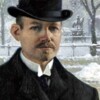


L'anniversaire du roi. La Garde royale en gala rouge à Øster (1925) Painting by Paul Gustav Fischer
"Fine-Arts" prints on paper
It is a process of printing on art paper using very high-quality pigment inks and printed in very high definition. Its level of conservation is exceptional (more than 100 years), its quality, depth, and richness of nuances exceeds the classic photo print on Argentic paper.

Glossy finish
Apart from its exceptional thickness, the fiber paper is composed of an alpha-cellulose base without acid and it is covered with barium sulphate, and a microporous layer absorption enhancing pigments during printing. A pure white color, non-yellowing to light, this paper is especially designed for resistance and aging. It is used by major museums worldwide as it offers excellent resolution, rendering deep and dense colors.
Art Print "Fine Art" - Glossy finish on a fiber base paper 325 g.

Our high end prints and reproductions
ArtMajeur only uses natural papers with neutral pH, resistant, and of high quality, selected from renowned papermakers!
Constant attention is paid by our master printer, whether in terms of color control or respect for the graphic chain. Our high level of quality requirement is a major asset of ArtMajeur framed art prints.
For Artists! You help artists to live from their work. They receive royalties everytime you buy their prints.
About our fine prints-
Original Artwork
Painting,
Oil
on Canvas
- Dimensions Height 59.1in, Width 59.1in
- Framing This artwork is not framed
- Categories Classicism Everyday Life
Related themes
Paul Fischer was born in Copenhagen, Denmark. He was the fourth generation of a Jewish family of Polish descent. Philip August Fischer (1817-1907) and Gustafva Albertina Svedgren (1827-1883) had him as a son. The family was upper-middle class. His father was a painter, but he made his living manufacturing paints and lacquers. In his mid-teens, he enrolled for two years at the Royal Danish Academy of Fine Arts in Copenhagen. This was the only time he received any formal art education. Fischer began painting at a young age. He was taught to do so by his father. He worked in his father's factory from 1878 to 1888 and often exhibited his works at the Charlottenborg Spring Exhibition from 1884 to 1902. Thanks to a painting he published in Ude og Hjemme, he met young Danish naturalists, and his reputation began to grow. His early paintings depicted how people lived in cities. For this reason, he was called the "Copenhagen Painter" (Kbenhavns maler). From 1891 to 1895, he lived in Paris, where he made his colors richer and clearer. Fischer became known as a painter of urban scenes, not only of Copenhagen, but also of places in Scandinavia, Italy, and Germany. He was at his peak between 1890 and 1910. He learned from his Norwegian and Swedish peers, especially Carl Larsson. During this time, he also painted bright, sunny scenes of people at the beach, some of them nude, and became interested in making posters after seeing the works of Théophile Steinlen and Henri de Toulouse-Lautrec. At the time Laurits Tuxen was painting, he was Denmark's most important artist. During his lifetime, Fischer did not receive much critical attention, but his works sold well. When Sweden returned Norway to the Norwegians, it was Fischer, not Tuxen, who was commissioned by the Norwegian king to paint the event. It was a major victory for Fischer over Tuxen.
Translated with DeepL.com (free version)
-
Nationality:
DENMARK

- Date of birth : 1860
- Artistic domains: Represented by a Gallery,
- Groups: Danish Contemporary Artists Artists presented by a gallery







